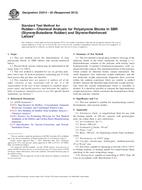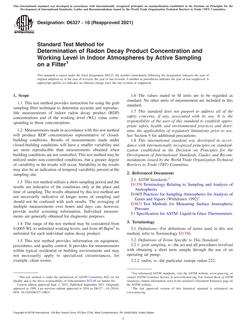1.1 This practice indicates how to test the oxidative degradation characteristics of plastics that degrade in the environment under atmospheric pressure and thermal and humidity simulations, only, in the absence of any selected disposal environment such as soil, landfill, or compost. This practice does not by any extension or extrapolation of data or results generated indicate that such plastics are suitable for or will degrade on disposal in these said environments. It is particularly noted that in real world environments such as soil, compost and landfill oxidations, if they occur, will predominantly be under conditions where other interfering ingredients are present and, in the case of landfill, at sub-atmospheric oxygen concentrations. This practice, therefore, can only result in a relative ordering of the potential for oxidation of plastic materials under the conditions tested, which are not always reflective of their behavior in a particular real world disposal systems. Prediction of the oxidation of a plastic under real world disposal conditions is an essential further testing in appropriate methodologies, such as Test Method D5338 for composting. No claims can be made for real world behavior based on this practice.
1.2 This practice is only intended to define the exposure conditions of plastics at various temperatures in air at atmospheric pressure under controlled humidity levels for extended periods of time. The humidity levels and temperature ranges are selected to be within the variable recorded seasonal ranges (upper and lower levels) generally observed in disposal sites where such plastics are discarded. For example: soil (15 to 40 percent moisture); landfill (35 to 60 percent moisture), and compost (45 to 70 percent moisture). It is optional to expose the plastic at zero humidity, if comparison with specified humidity ranges is of interest. Only the procedures for heat and humidity exposures are specified, not the test method or specimen, necessary for the evaluation of the heat and humidity exposure effects. The effect of heat and humidity on any particular property is determined by selection of the appropriate test method and specimen; however, it is recommended that Practice D3826 be used to determine the embrittlement endpoint, which is defined as that point in the history of a material when 75 % of the specimens tested have a tensile elongation at break of 5 % or less at an initial strain rate of 0.1 mm/mm min.
1.3 This practice is used to compare the effects of heat and humidity at any selected temperature, such as those found in the mentioned disposal environments, on the degradation of a particular plastic by selection of an appropriate test method and specimen.
1.4 This practice is to be used in order to apply selected exposure conditions when comparing the thermal-aging characteristics at controlled humidity levels of plastic materials as measured by the change in some property of interest (that is, embrittlement by means of loss of elongation, molecular weight, disintegration, etc.). It is very similar to Practice D3045 but is intended for use in evaluating plastics designed to be oxidized easily after use. The exposure times used for this practice will be significantly shorter than those used for Practice D3045
1.5 The type of oven used can affect the results obtained from this practice. The user can use one of two methods for oven exposure. Do not mix the results based on one method with those based on the other one.
1.6 Procedure A: Gravity-Convection Oven – Recommended for film specimens having a nominal thickness not greater than 0.25 mm (0.010 in.).
1.7 Procedure B: Forced-Ventilation Oven – Recommended for specimens having a nominal thickness greater than 0.25 mm (0.010 in.).
1.8 This practice recommends procedures for comparing the thermal and humidity aging characteristics of materials at a single temperature under dry or selected humidity conditions. Recommended procedures for determining the thermal aging characteristics of a material at a series of temperatures and humidity conditions for the purpose of estimating time to a defined property change at some lower temperature are also described. This practice does not predict thermal aging characteristics where interactions between stress, environment, temperature, and time control failure.
1.9 The values stated in SI units are to be regarded as the standard.
1.10 The values stated in inch-pound units are to be regarded as standard. The values given in parentheses are mathematical conversions to SI units that are provided for information only and are not considered standard.
Note 1 – There is no known ISO equivalent to this standard.
Product Details
- Published:
- 03/15/2011
- Number of Pages:
- 6
- File Size:
- 1 file , 140 KB


